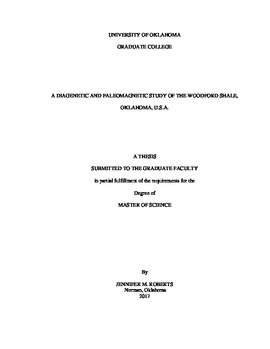| dc.description.abstract | Two Woodford Shale cores from the Anadarko Basin (Core A, Core C) and one oriented Woodford Shale core from the Ardmore Basin near the Ouachita thrust zone (Core B) were sampled in order to identify diagenetic events, interpret their origin, and uncover the diagenetic history of the shale. Additionally, Core B was examined to test the hypotheses that the Woodford Shale was altered by external, hydrothermal fluids, and contains a magnetization that can be used to date the altering event(s). The Woodford Shale is one of the key hydrocarbon source rocks and unconventional reservoirs in the mid-continent. Understanding the role that diagenetic processes have is fundamental to optimizing our exploitation of the unit.
Thin sections for all cores were analyzed using a variety of methods, such as scanning electron microscopy (SEM) and x-ray computed tomography (XRCT). The shale is extensively altered, exhibiting a complex paragenesis. Multiple fractures and brecciated intervals are common. Early diagenesis is dominated by events in the matrix and allochems, with later diagenesis dominated by events associated with fracturing and brecciation. Cathodoluminescence within fractures reveals evidence of evolving fluids and multiple fluid-flow events. Multiple hydrothermal minerals are present, including biotite, magnesite, norsethite, witherite, gorceixite, potassium feldspar, sphalerite, chalcopyrite, and saddle dolomite. Other minerals present in fractures are albite, apatite, calcite, dolomite, quartz, pyrite, and barite.
Vitrinite reflectance and bitumen reflectance data converted to a vitrinite reflectance equivalent (VRE) reveal trends between thermal maturity and the level of hydrothermal alteration, with Core A (0.80% VRo (~125°C)) displaying the lowest alteration, and Cores C (~1.5% VRo (~210°C)) and B (~1.82% VRo (~230°C)) displaying the highest alteration. Paleomagnetic analysis of Core B reveals the presence of a characteristic remanent magnetization (ChRM) with south-southeasterly declinations and shallow inclinations that is unblocked by 450°C and is interpreted to reside in magnetite. This ChRM is interpreted to be either a chemical remanent magnetization (CRM) or a thermochemical remanent magnetization (TCRM) acquired during the Late Permian. The presence of specimens with the CRM/TCRM in altered rock and the high thermal maturities suggests that this CRM/TCRM originated from alteration by hydrothermal fluids. These results suggest that the Woodford Shale evolved into an open diagenetic system. In addition to causing heightened thermal maturities, these hydrothermal fluids both increased porosity through dissolution and decreased porosity through precipitation of minerals.The Late Permian timing agrees with the dating of hydrothermal alteration found within the Ouachita and Arbuckle Mountains by other workers. The timing for these events is postcollisional, and the most consistent model for the origin of the hydrothermal minerals is fluid flow as a result of faulting that accessed reservoir(s) of warm fluids and facilitated movement. | en_US |
